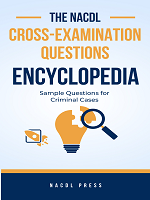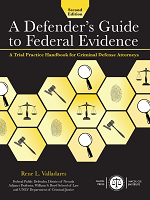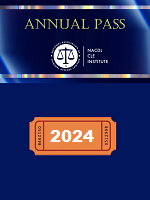Access to The Champion archive is one of many exclusive member benefits. It’s normally restricted to just NACDL members. However, this content, and others like it, is available to everyone in order to educate the public on why criminal justice reform is a necessity.
In 1984, Congress passed the Sentencing Reform Act which, among other things, provided federal district courts with limited authority to review and reduce a defendant’s sentence under what has become known as the “compassionate release” program.{1} 1 18 U.S.C. 3582(C)(1). Under the old program, the Bureau of Prisons (“BOP”) could file a motion for compassionate release with the district court if there existed “extraordinary and compelling reasons” to modify the defendant’s original sentence. Congress tasked the United States Sentencing Commission (“USSC”) with defining what constitutes extraordinary and compelling reasons, such as a terminal illness or advanced age.{2} 2 18 U.S.C. 994(t). The BOP was meant to identify those prisoners who met the USSC criteria and file a motion for compassionate release on their behalf. In the rare instances when the BOP filed such a motion, the sentencing court would decide if a reduction of the prisoner’s sentence was warranted in light of the Section 3553(a) factors.
For over three decades, the BOP retained unlimited and unreviewable discretion to refuse to file compassionate release motions, no matter how deserving the prisoner’s case facially appeared. BOP’s own statistics highlighted the problem. “[B]etween 2013 and 2017 [the BOP] received 5,400 requests for compassionate release. The BOP approved 312 requests during that time frame, but 266 prisoners died while still in custody.”{3} 3 https://www.law360.com/articles/1153056/the-first-step-act-is-a-major-step-for-sentencing-reform (last visited Nov. 25, 2019). This all changed on Dec. 21, 2018, when the president signed the First Step Act of 2018 into law. Among other reforms, Congress amended 18 U.S.C. § 3582 to permit defendants to file their own motions for compassionate release when (1) their requests are denied by the BOP or (2) the BOP simply fails to respond to a defendant’s request within 30 days of its submission.{4} 4 18 U.S.C. 3582(C)(1)(A). For a sentencing court to grant a defendant’s motion for compassionate release under the First Step Act, it must find that (1) it has jurisdiction to entertain the motion — i.e., that the prisoner has exhausted his administrative remedies or waited 30 days from the date of his request, (2) extraordinary and compelling reasons exist to warrant the reduction, (3) the reduction is consistent with the USSG § 1B1.13 policy statement — i.e., the defendant is not a danger to any other person or to the community,{5} 5 Given that many of the § 3142 factors are addressed in § 3553(a), these two sections are often discussed together. See United States v. Beck, 2019 WL 2716505 (M.D.N.C. June 28, 2019). and (4) the reduction is consistent with the sentencing factors detailed in 18 U.S.C. § 3553(a).{6} 6 See 18 U.S.C. § 3582(c)(1)-(2); USSG § 1B1.13 (Nov. 1, 2018).
Thus, as one court recently noted, “[t]he First Step Act did not change the statutory criteria for compassionate release, but it did change the procedures, so that the Bureau of Prisons is no longer an obstacle to a court’s consideration of whether compassionate release is appropriate.”{7} 7 United States v. Fox, 2019 WL 3046086, at *3 (D. Me. July 11, 2019).
What Qualifies as an Extraordinary and Compelling Reason?
In 1984, Congress expressly delegated to the USSC the task of defining what exactly an “extraordinary and compelling reason” is under Section 3582(c)(1)(A)(i).{8} 8 28 U.S.C.A. § 994(t) (“The Commission, in promulgating general policy statements regarding the sentencing modification provisions in Section 3582(c)(1)(A) of Title 18, shall describe what should be considered extraordinary and compelling reasons for sentence reduction, including the criteria to be applied and a list of specific examples.”). Under amended Section 3582(c)(1)(A)(i), a sentencing court “must consider the Sentencing Commission policy statement, [and] the court cannot give any weight to a [BOP] program statement that is inconsistent with those policy statements.”{9} 9 United States v. Laughlin, Case No. 12-30081, 7 (C.D. Ill. Sept. 23, 2019). The Commission’s policy statement 1B1.13 provides three examples that may qualify as extraordinary and compelling reasons to justify a reduction in sentence. First, a medical condition may qualify as grounds justifying a sentence reduction when, inter alia, “the [prisoner] is suffering from a terminal illness (i.e., a serious and advanced illness with an end of life trajectory). A specific prognosis of life expectancy (i.e., a probability of death within a specific time period) is not required. Examples include metastatic solid-tumor cancer.”{10} 10 U.S.S.G. 1B1.13, Application Note (1)(A)(i). Second, an extraordinary and compelling reason exists when a prisoner is 65 years old, experiencing a serious deterioration in physical or mental health, and has served at least 10 years or 75 percent of his term of imprisonment (whichever is less). Finally, a basis for sentence reduction might exist if there is a death or incapacitation of the caregiver of the defendant’s minor child, or there has been an incapacitation of the prisoner’s spouse and the defendant would be the only available caregiver for that person.
However, there has been significant disagreement among district courts as to the “binding effect” of the current USSC definitions of “extraordinary and compelling reason” because the Commission’s policy statements have not been updated since the enactment of the First Step Act.{11} 11 See United States v. Fox, 2019 WL 3046086, at *2 (D. Me. July 11, 2019) (“One district court has concluded that this policy statement -- endnote Moreover, this problem is not likely to be solved in the immediate future as the Sentencing Commission sits without a quorum: “[W]ith only two current commissioners, the Commission is unable to pass amendments to make the sentencing guidelines consistent with the statutory provision.”{12} 12 https://www.law360.com/articles/1153056/the-first-step-act-is-a-major-step-for-sentencing-reform (last visited Nov. 25, 2019). While NACDL takes the position that BOP program statement 5050.50 and USSC policy statement 1B1.13 are superseded by the First Step Act, removing those restrictions on what constitutes an “extraordinary and compelling reason,” until the law is settled, prisoners seeking compassionate release may still find it advisable to look to those statements for guidance.{13} 13 Shon R. Hopwood, Second Looks & Second Chances, 41 Cardozo L. Rev. 83 (2019).
It is important to note that in many ways the BOP program statement is much more restrictive than the USSC policy statement; for example, under current BOP guidelines, the grounds for compassionate release must have been “unforeseeable” to the sentencing judge in order for it to be considered.{14} 14 See Bureau of Prisons Program Statement 5050.50. However, the Commission considered and rejected BOP’s “unforeseeability” requirement at the time of sentencing:
[A]n extraordinary and compelling reason need not have been unforeseen at the time of sentencing in order to warrant a reduction. The Commission heard from stakeholders and medical experts that the corresponding limitation in the Bureau of Prisons’ program statement ignores the often-precipitous decline in health or circumstances that can occur after imprisonment. …{15} 15 799 U.S.S.G. Supp. to App. C at 138 (Nov. 2016).
As such, until the conflict between the BOP and Sentencing Commission guidelines has been resolved, it is important for prisoners who had a pre-existing condition at the time of sentencing to demonstrate how their condition has worsened or changed since the time of sentencing.{16} 16 See United States v. Bellamy, 2019 WL 3340699 (D. Minn. July 25, 2019).
Section 3553(a) Sentencing Factors
A compassionate release motion should not include a simple recitation of the original sentencing argument. It is important to highlight changes in the defendant’s circumstances since the initial sentencing. In Pepper v. United States,{17} 17 Pepper v. United States, 562 U.S. 490-93 (2011). the Supreme Court held that a sentencing court can, and indeed must, consider postsentencing developments under Section 3553(a), which provide the “most up-to-date picture” of the defendant’s history and characteristics and “shed[] light on the likelihood that [the defendant] will engage in future criminal conduct.{18} 18 Id. at 492.
In the USSC’s policy statement on physical condition, extraordinary impairments provide reasons for downward departures for “seriously infirm” defendants, including to home detention at initial sentencing “as efficient as, and less costly than, imprisonment.”{19} 19 U.S.S.G. § 5H1.4; see also 18 U.S.C. § 3553(a)(2)(D) (consideration of providing needed medical care in the most effective manner). Indeed, the Department of Justice recognized that “the stress imposed by incarceration can exacerbate the health problems of elderly and infirm inmates,” and recognizes that institutionalization “may increase chronic disease symptoms.”{20} 20 See Addressing the Needs of Elderly, Chronically Ill, and Terminally Ill Inmates, Department of Justice (2004), https://nicic.gov/correctional-health-care-addressing-needs-elderly-chronically-ill-and-terminally-ill-inmates (last visited Nov. 29, 2019). Moreover, it is important to point out that many offenders seeking compassionate release will be older individuals with a very low likelihood of reoffending. “Studies have repeatedly shown older offenders to have a lower risk of reoffending. … Just 16.0 percent of offenders older than 60 years of age at the time of release were rearrested. In comparison, more than two-thirds (67.6 percent) of offenders younger than 21 at the time of release were rearrested.”{21} 21 See generally The Effects of Aging on Recidivism Among Federal Offenders (December 2017) (USSC) (https://www.ussc.gov/research/research-reports/recidivism-among-federal-offenders-comprehensive-overview) (last visited Nov. 21, 2019). Finally, as part of any compassionate release motion, a plan for treatment and release needs to be presented to the court. This is a multistep process that the defendant begins by submitting a request to BOP personnel for a reduction in sentence. A “home visit” must be scheduled by BOP personnel and a plan formulated for the release of the individual if the court grants the motion.
Conclusion
Lawyers preparing motions for compassionate release for inmates facing extreme circumstances such as terminal and age-related illnesses should contact NACDL or Families Against Mandatory Minimums (“FAMM”) for information about the Compassionate Release Clearinghouse, which is managed by lawyers from FAMM, NACDL, and the Washington Lawyers’ Committee for Civil Rights and Urban Affairs.{22} 22 https://famm.org/our-work/compassionate-release. FAMM’s website contains links to relevant statutes, BOP policy statements, U.S. Sentencing Commission Guidelines, a report on compassionate release programs available in 51 jurisdictions, and compassionate release data from the Bureau of Prisons. The Clearinghouse also provides free advice and resources to lawyers willing to represent indigent defendants such as sample motions, assistance in navigating the BOP records system, and preparing Re-entry Plans to assist lawyers drafting and arguing compassionate release motions. The Compassionate Release Clearinghouse is always looking for attorneys to represent indigent prisoners who have not qualified for assigned counsel to petition courts around the country and argue their cases. You can help end the continued incarceration of a prisoner facing death behind bars by volunteering to take one of these cases.
About the Author
Nina J. Ginsberg a founding partner at DiMuroGinsberg, P.C., in Alexandria, Virginia, has practiced criminal law for more than 35 years. She has represented individuals and corporations in a wide range of matters, with a focus on national security law, white collar investigations and prosecution, financial and securities fraud, computer crime, copyright fraud, and professional ethics.
Nina J. Ginsberg (NACDL Member)
DiMuroGinsberg, P.C.
Alexandria, Virginia
703-684-4333
nginsberg@dimuro.com
www.dimuro.com
@DiMuroGinsberg
Endnote
- See United States v. Fox, 2019 WL 3046086, at *2 (D. Me. July 11, 2019) (“One district court has concluded that this policy statement (which it characterizes as ‘old’ now that the First Step Act has been enacted) ‘provides helpful guidance,’ but ‘does not constrain the court’s independent assessment’); see United States v. Beck, 2019 WL 2716505, at *6, 9 (M.D.N.C. June 28, 2019); accord United States v. Cantu, 2019 WL 2498923, at * 5 (S.D. Tex. June 17, 2019) (factor D — Other Reasons as determined by BOP — is no longer binding). Other courts seem to treat the current policy statement as binding even after the First Step Act. See, e.g., United States v. Solis, 2019 WL 2518452, at *2-3 (S.D. Ala. June 28, 2019); United States v. Johns, 2019 WL 2646663, at *1, 3 (D. Ariz. June 27, 2019); United States v. Gross, 2019 WL 2437463, at *3 (E.D. Wash. June 11, 2019); United States v. Gutierrez, 2019 WL 2422601, at *1-2 (D.N.M. June 10, 2019); United States v. Heromin, 2019 WL 2411311, at *2 (M.D. Fla. June 7, 2019); United States v. Willis, 2019 WL 2403192, at *2 (D.N.M. June 7, 2019); United States v. Shields, 2019 WL 2359231, at *4 (N.D. Cal. June 4, 2019) (“Shields has not cited, and the court has not discovered, any authority for the proposition that the court may disregard guidance provided by the Sentencing Commission where it appears that such guidance has not kept pace with statutory amendments.”); United States v. Clark, 2019 WL 1052020, at *2 (W.D.N.C. Mar. 5, 2019).”). (^ return)






